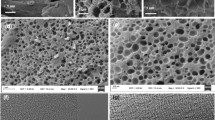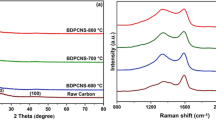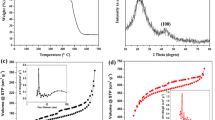Abstract
Hierarchical porous carbon materials with high surface area are facilely prepared by directly carbonizing carex meyeriana without any extra activation procedure. The as-prepared porous carbon samples possess high Brunauer–Emmett–Teller (BET) surface areas (in the ~ 518–742 m2 g−1 range) and unique hierarchical porous structure containing macropore channels and mesopores and micropores developed in the wall of macropores. These intriguing characteristics make the as-prepared hierarchical porous carbon samples a promising electrode material for supercapacitors. The capacitive performance was measured in the three-electrode system with 6 M KOH electrolyte. The hierarchical porous carbon prepared at the carbonization temperature of 1000 °C presents a high specific capacitance of 178.6 F g−1 at a current density of 0.5 A g−1, a good rate performance ( about 65.2% retention ratio at the current density of 20 A g−1), and an excellent cycling stability (no obvious performance fading after 10,000 cycles). In addition, the fabricated two-electrode device achieves an energy density of 4.33 Wh kg−1 at a high power density of 5 kW kg−1. These results provide a green and facile method to synthesize the electrode material from biomass for high-performance supercapacitors.







Similar content being viewed by others
References
M. Beidaghi, Y. Gogotsi, Capacitive energy storage in micro-scale devices: recent advances in design and fabrication of micro-supercapacitors. Energy Environ. Sci. 7, 867–884 (2014)
F. Bonaccorso, L. Colombo, G. Yu, Graphene, related two-dimensional crystals, and hybrid systems for energy conversion and storage. Science 347, 1246501–1246509 (2015)
M. Winter, R.J. Brodd, What are batteries, fuel cells, and supercapacitors? Chem. Rev. 104, 4245–4270 (2004)
G. Wang, L. Zhang, J. Zhang, A review of electrode materials for electrochemical supercapacitors. Chem. Soc. Rev. 41, 797–828 (2012)
P.J. Hall, M. Mirzaeian, S.I. Fletcher, Energy storage in electrochemical capacitors: designing functional materials to improve performance. Energy Environ. Sci. 3, 1238–1251 (2010)
H. Ji, X. Zhao, Z. Qiao, Capacitance of carbon-based electrical double-layer capacitors. Nat. Commun. 5, 3317–3323 (2014)
V. Augustyn, P. Simon, B. Dunn, Pseudocapacitive oxide materials for high-rate electrochemical energy storage. Energy Environ. Sci. 7, 1597–1614 (2014)
S. Subhadarshini, E. Pavitra, G. Seeta Rama Raju, N.R. Chodankar, D.K. Goswam, Y. Han, Y. Huh, N. Das, One-dimensional NiSe-Se hollow nanotubular architecture as a binder-free cathode with enhanced redox reactions for high-performance hybrid supercapacitors. ACS Appl. Mater. Interfaces 12, 29302–29315 (2020)
S. Subhadarshini, E. Pavitra, One-pot facile synthesis and electrochemical evaluation of selenium enriched cobalt selenide nanotube for supercapacitor application. Ceram. Inter. 47, 15293–15306 (2021)
K. Xie, X. Qin, X. Wang, Carbon nanocages as supercapacitor electrode materials. Adv. Mater. 24, 347–352 (2012)
A. Vlad, A. Balducci, Supercapacitors: porous materials get energized. Nat. Mater. 16, 161–162 (2017)
L. Zhang, X. Yang, F. Zhang, Controlling the effective surface area and pore size distribution of sp2 carbon materials and their impact on the capacitance performance of these materials. J. Am. Chem. Soc. 135, 5921–5929 (2013)
Z. Ling, G. Wang, M. Zhang, Boric acid-mediated B N-codoped chitosan-derived porous carbons with a high surface area and greatly improved supercapacitor performance. Nanoscale 7, 5120–5125 (2015)
M. Zhu, F. Pu, Z. Wang, Nitrogen-doped porous carbons through KOH activation with superior performance in supercapacitors. Carbon 68, 185–194 (2014)
Y. Zhang, B. Tao, X. Xing, Sandwich-like nitrogen-doped porous carbon/graphene nanofl akes with high-rate capacitive performance. Nanoscale 8, 7889–7898 (2016)
F. Guo, X. Jiang, X. Li, K. Peng, C. Guo, Z. Rao, Carbon electrode material from peanut shell by one-step synthesis for high performance supercapacitors. J. Mater. Sc. Mater. Electron. 30, 914–925 (2019)
T. Zhu, J. Zhou, Z. Li, Hierarchical porous and N-doped carbon nanotubes derived from polyaniline for electrode materials in supercapacitors. J. Mater. Chem. A 2, 12545–12551 (2014)
S. Hou, M. Liu, L. Wu, Methane sulfonic acid-assisted synthesis of N/S co-doped hierarchically porous carbon for high performance supercapacitors. J. Power Sources 387, 81–90 (2018)
D. Zhang, M. Han, B. Wang, Superior supercapacitors based on nitrogen and sulfur co-doped hierarchical porous carbon: excellent rate capability and cycle stability. J. Power Sources 358, 112–120 (2017)
Y. Pan, Y. Zhao, S. Mu, Cation exchanged MOF-derived nitrogen-doped porous carbons for CO2 capture and supercapacitor electrode materials. J. Mater. Chem. A 5, 9544–9552 (2017)
J. Zhang, L. Jin, J. Chen, Hierarchical porous carbons prepared from direct coal liquefaction residue and coal for supercapacitor electrodes. Carbon 55, 221–232 (2013)
Q. Zhao, X. Wang, C. Wu, Supercapacitive performance of hierarchical porous carbon microspheres prepared by simple one-pot method. J. Power Sources 254, 10–17 (2014)
X. Fan, C. Yu, J. Yang, A layered-nanospace-confinement strategy for the synthesis of two-dimensional porous carbon nanosheets for high-rate performance supercapacitors. Adv. Energy Mater. 5, 1401761 (2015)
D. Zhang, M. Han, B. Wang, Supercapacitors based on nitrogen and sulfur co-doped hierarchical porous carbon: excellent rate capability and cycle stability. J. Power Sources 358, 112–120 (2017)
Y. Tang, S. Liu, B. Zheng, Activation-free fabrication of high-surface-area porous carbon nanosheets from conjugated copolymers. Chem. Commun. 54, 11431–11434 (2018)
S. Subhadarshini, R. Singh, D.K. Goswarmi, A.K. Das, NCh. Das, Electrodeposited Cu2O nanopetal architecture as superhydrophobic and antibacterial surface. Langmuir 35, 17166–17176 (2019)
A. Kalijadis, J. Đorđević, M. Vukčević, Z. Laušević, Preparation of boron-doped hydrothermal carbon from glucose for carbon paste electrode. Carbon 95, 42–50 (2015)
X. Lin, Y. Liang, Z. Lu, Mechanochemistry: a green, activation-free and top-down strategy to high-surface-area carbon materials. ACS Sustain. Chem. Eng. 5, 8535–8540 (2017)
X. Lin, Y. Tang, Q. Su, Hierarchical porous carbon materials: structure design, functional modification and new energy devices applications. CIESC Journal 7, 2586–2598 (2020)
H. Lu, X. Zhao, Biomass-derived carbon electrode materials for supercapacitors. Sustain. Energy Fuels 1, 1265–1281 (2017)
X. Hao, J. Wang, B. Ding, Bacterial-cellulose-derived interconnected meso-microporous carbon nanofiber networks as binder-free electrodes for high-performance supercapacitors. J. Power Sources 352, 34–41 (2017)
J. Deng, M. Li, Y. Wang, Biomass-derived carbon: synthesis and applications in energy storage and conversion. Green Chem. 18, 4824–4854 (2016)
S. Lu, M. Jin, Y. Zhang, Chemically exfoliating biomass into a graphene-like porous active carbon with rational pore structure, good conductivity, and large surface area for high-performance supercapacitors. Adv. Energy Mater. 8, 1702545 (2018)
T. Wei, X. Wei, L. Yang, A one-step moderate-explosion assisted carbonization strategy to sulfur and nitrogen dual-doped porous carbon nanosheets derived from camellia petals for energy storage. J. Power Sources 331, 373–381 (2016)
R. Berenguer, F.J. García-Mateos, R. Ruiz-Rosas, Biomass-derived binderless fibrous carbon electrodes for ultrafast energy storage. Green Chem. 18, 1506–1515 (2016)
Y. Zhang, S. Liu, X. Zheng, Biomass organs control the porosity of their pyrolyzed carbon. Adv. Funct. Mater. 27, 1–8 (2017)
X. Yu, Y. Wang, L. Li, H. Li, Y. Shang, Soft and wrinkled carbon membranes derived from petals for flexible supercapacitors. Sci. Rep. 7, 1–8 (2017)
C. Zequine, C.K. Ranaweera, Z. Wang, Z.P. Tripathi, K. Ramasamy, P.R. Dvornic, R.K. Gupta, High performance and flexible supercapacitors based on carbonized bamboo fibers for wide temperature applications. Sci. Rep. 6, 1–10 (2016)
S. Gao, K. Geng, H. Liu, P. Wang, J. Wang, Transforming organic-rich amaranthus waste into nitrogen-doped carbon with superior performance of the oxygen reduction reaction. Energy Environ. Sci. 8, 221–229 (2015)
X. Wang, D. Kong, Y. Zhang, Q. Song, J. Ning, Y. Song, L. Zhi, All-biomaterial supercapacitor derived from bacterial cellulose. Nanoscale 8, 9146–9150 (2016)
X. Su, J. Chen, G. Zheng, J. Yang, X. Guan, P. Liu, X. Zheng, Three-dimensional porous activated carbon derived from loofah sponge biomass for supercapacitor applications. Appl. Surf. Sci. 436, 327–336 (2018)
Z. Wang, P. Tammela, M. Strømme, L. Nyholm, Cellulose-based supercapacitors: material and performance considerations. Adv. Energy Mater. 7, 1700130 (2017)
M. Sevilla, A.B. Fuertes, Direct synthesis of highly porous interconnected carbon nanosheets and their application as high-performance supercapacitors. ACS Nano 8, 5069–5078 (2014)
Y. Yoon, K. Lee, S. Kwon, S. Seo, Y. Shin, Y. Park, D. Kim, J.Y. Choi, H. Lee, Vertical alignments of graphene sheets spatially and densely piled for fast ion diffusion in compact supercapacitors. ACS Nano 8, 4580–4590 (2014)
Acknowledgements
This work is supported by Education Department of Liaoning Province (201901003)
Author information
Authors and Affiliations
Corresponding author
Ethics declarations
Conflict of interest
The authors declare that they have no known competing financial interests or personal relationships that could have appeared to influence the work reported in this paper.
Additional information
Publisher's Note
Springer Nature remains neutral with regard to jurisdictional claims in published maps and institutional affiliations.
Supplementary Information
Below is the link to the electronic supplementary material.
Rights and permissions
About this article
Cite this article
Wang, G., Bi, J., Lei, M. et al. Hierarchical porous carbon obtained from directly carbonizing carex meyeriana for high-performance supercapacitors. J Mater Sci: Mater Electron 32, 21278–21287 (2021). https://doi.org/10.1007/s10854-021-06630-x
Received:
Accepted:
Published:
Issue Date:
DOI: https://doi.org/10.1007/s10854-021-06630-x




